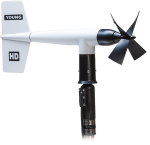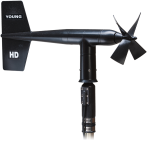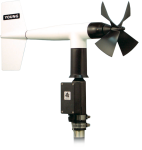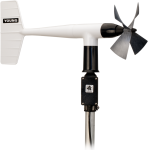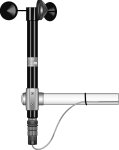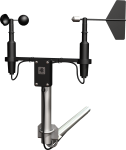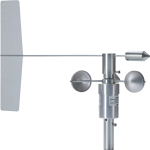Este producto sufre disponibilidad limitada. Será sustituido por: 05108-L. En caso de que quedara descatalogado, podrían seguir estando disponibles accesorios, recambios, u otros servicios.
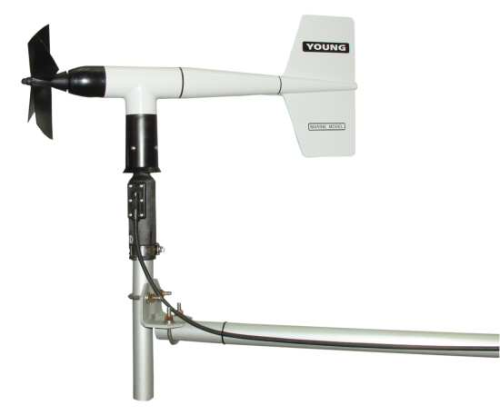
Compatible con la mayoría de dataloggers Campbell Scientific






Resumen
El 05106 Wind Monitor es un instrumento ligero y robusto que mide la velocidad y dirección del viento en duras condiciones ambientales, diseñado para uso "offshore" en condiciones marinas. Fabricado por R. M. Young, este sensor de viento se integra fácilmente con nuestros dataloggers Campbell Scientific.
Leer másVentajas y características
- Cojinetes lubricados y sellados a prueba de agua, con cable de calidad e hilos al aire (sin la típica caja de conexiones)
- Compatible con la mayoría de dataloggers Campbell Scientific
- Suficientemente robusto para uso en duras condiciones ambientales
- Construido en material termoplástico que resiste la corrosión de ambientes marinos y de contaminantes atmosféricos
- Compatible con el LLAC4 4-channel Low Level AC Conversión Module, el cual incrementa el número de anemómetros que puede medir un datalogger
- Usa cojinetes de bola de precisión, en acero inoxidable, en el eje de la hélice y en el vertical
- Compatible con interfaces serie CWS900, para usarse en redes de sensores inalámbricos
Imágenes




Descripción detallada
The 05106 Wind Monitor-MA is made out of rigid UV-stabilized thermoplastic with stainless steel and anodized aluminum fittings. The thermoplastic material resists corrosion from sea air environments and atmospheric pollutants. It uses stainless-steel precision-grade ball bearings for the propeller shaft and vertical shaft bearings.
To make it more durable in offshore and marine applications, the 05106 has waterproof bearing lubricant and a sealed, heavy-duty cable pigtail instead of the standard junction box.
The 05106 measures wind speed with a helicoid-shaped, four-blade propeller. Rotation of the propeller produces an ac sine wave that has a frequency directly proportional to wind speed. The ac signal is induced in a transducer coil by a six-pole magnet mounted on the propeller shaft. The coil resides on the non-rotating central portion of the main mounting assembly, eliminating the need for slip rings and brushes.
Wind direction is sensed by the orientation of the fuselage-shaped sensor body, which is connected to an internal potentiometer. The datalogger applies a known precision excitation voltage to the potentiometer element. The output is an analog voltage signal directly proportional to the azimuth angle.
Productos similares
Preguntas frecuentes
Número de FAQs relacionadas con 05106: 5
Expandir todoDesplegar todo
-
The measurement instructions will likely remain the same. However, in addition to the multiplier and offset, the type of pulse may change for the wind speed, and the excitation voltage may change for the wind direction. For an explanation of how the datalogger needs to be programmed, see the instruction manual.
-
This depends on what is broken. Typically, Campbell Scientific can repair the unit, and the user does not have to purchase a new one.
-
- Using Short Cut, click the applicable wind direction sensor in the Selected Sensors list of the Outputs screen.
- The two output options enabled are Sample and WindVector. Select WindVector.
- The WindVector instruction has output options. Select an option with mean wind direction in it.
-
The information included on a calibration sheet differs with each sensor. For some sensors, the sheet contains coefficients necessary to program a datalogger. For other sensors, the calibration sheet is a pass/fail report.
-
To incorporate a sensor that is compatible with wireless sensor interfaces into a wireless network, a CWS900-series wireless sensor interface is needed, as well as an A205 CWS-to-PC interface to configure it.
Compatibilidad
Nota: lo siguiente muestra información de compatibilidad notable. No es una lista de todos los productos compatibles.
Dataloggers
| Producto | Compatible | Nota |
|---|---|---|
| CR500 (retired) | Measurements are typically processed for output with the Wind Vector instruction, which is not present in the CR500. | |
| CR9000 (retired) | Measurements are typically processed for output with the Wind Vector instruction, which is not present in the CR9000. |
Información de compatibilidad adicional
Data Logger Considerations
The 05106-L is compatible with most of our data loggers.
Especificaciones
| Operating Temperature Range | -50° to +50°C (assuming non-riming conditions) |
| Mounting Pipe Description |
|
| Propeller Diameter | 18 cm (7.1 in.) |
| Overall Height | 37 cm (14.6 in.) |
| Overall Length | 55 cm (21.7 in.) |
| Main Housing Diameter | 5 cm (2.0 in.) |
| Weight | 1.5 kg (3.2 lb) |
Wind Speed |
|
| Range | 0 to 100 m/s (0 to 224 mph) |
| Accuracy | ±0.3 m/s (0.6 mph) or 1% of reading |
| Starting Threshold | 1.1 m/s (2.4 mph) |
| Distance Constant | 2.7 m (8.9 ft) 63% recovery |
| Output |
ac voltage (three pulses per revolution) 90 Hz (1800 rpm) = 8.8 m/s (19.7 mph) |
| Resolution | (0.0980 m s-1)/(scan rate in seconds) or (0.2192 mph)/(scan rate seconds) |
Wind Direction |
|
| Mechanical Range | 0 to 360° |
| Electrical Range | 355° (5° open) |
| Accuracy | ±3° |
| Starting Threshold | 1.1 m/s (2.4 mph) at 10° displacement |
| Distance Constant | 1.3 m (4.3 ft) 50% recovery |
| Damping Ratio | 0.3 |
| Damped Natural Wavelength | 7.4 m (24.3 ft) |
| Undamped Natural Wavelength | 7.2 m (23.6 ft) |
| Output |
|
| Voltage | Power switched excitation voltage supplied by data logger |
Documentos
Videos & Tutoriales
Casos de aplicación
The Delaware Environmental Observing System (DEOS) is a real-time system dedicated to monitoring environmental conditions......leer más
The meteorological stations at the Interuniversity Institute for Marine Sciences at Eilat (IUI) in Israel......leer más
Campbell Scientific's CR10X is the heart of a unique weather station project installed on the......leer más
